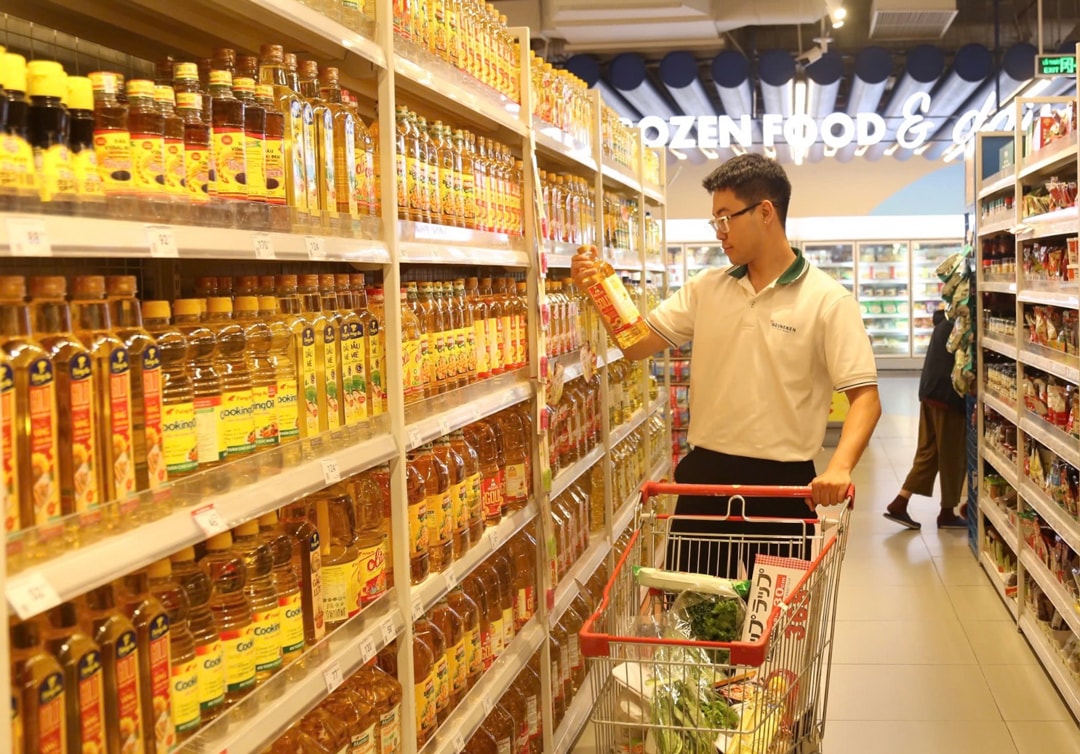Vietnamese goods in rising demand among Hanoi residents
The domestic market, estimated to be worth US$180 billion and projected to grow to US$350 billion by 2025, presents an opportunity for Vietnamese goods to gain a foothold domestically.
With ever-improving designs and quality at affordable prices, Vietnamese goods are gaining the trust of consumers in Hanoi and across the country, which is largely proven through promotion campaigns.
After nearly 15 years, the "Vietnamese Give Priority to Using Vietnamese Goods" campaign has shown promising results, according to the Ministry of Industry and Trade. In particular, the proportion of Vietnamese customers using Vietnamese products has increased significantly from 73% to over 85%.
A survey of several supermarkets in Hanoi shows that Vietnamese products on the shelves are becoming increasingly diverse, far outnumbering imported products. Among them, food products make up the majority. At the GO!/Big C supermarket chain in the capital, for example, Vietnamese goods account for more than 90% of the total, with some 45,000 products of all kinds.
In the WinMart and WinMart+ supermarket chains, Vietnamese goods always account for 80-90% in terms of quantity and variety. Sales of agricultural products account for more than 30%.
Consumers shop at the WinMart supermarket in Hanoi's Dong Da District. Photo: Hanoimoi |
A survey by the Association of High-Quality Vietnamese Goods Enterprises found that most vendors believe that 80% of the products sold by association members are popular and meet the requirements of high-quality Vietnamese goods. Among these enterprises, 39% offer competitive prices, 47% offer assorted products, and 60% have trustworthy brands.
More than 50% of respondents agreed that Vietnamese companies have introduced many new or improved products in the past year. This shows the growing confidence and acceptance of Vietnamese goods.
Not only agricultural products, food, and household appliances, but also school supplies from local enterprises have dominated the domestic market in recent years. Surveys in bookstores in Fahasa, Nha Nam, Tien Phong, Tri Duc, and Tien Tho show that school supplies from domestic producers are abundant and varied in design and now account for 80% of bookstore stocks.
Nguyen Thi Kim Dung, Director of Co.op Mart Ha Dong Supermarket, said that Co.op Mart has recently made efforts to promote Vietnamese goods to local consumers. The supermarket chain provides guidance to businesses, cooperatives, and farming households on the necessary conditions to put Vietnamese and OCOP products on the system's shelves.
Nguyen Thi Hai Thanh, Director of AEON Ha Dong General Merchandise Center and Supermarket said that Vietnamese vendors frequently change the designs of their products and run weekly and monthly sales. Vietnamese products have a strong sense of brand identification, and some of them compete fiercely with imports.
Trust-building needed
To further cement the position of Vietnamese goods, Nguyen Anh Duc, Chairman of the Vietnam Retailers Association, said the first step is to build trust among consumers.
"Vietnamese enterprises need to increase investment in research and development, technological innovation, and improve production processes in line with the green and circular economy trend; focus on building and protecting brands, improving management capacity, and developing effective distribution channels. They should also focus on developing the domestic retail system to create more opportunities for Vietnamese goods to reach consumers," Duc said.
The domestic market, estimated to be worth US$180 billion and projected to grow to US$350 billion by 2025, presents an opportunity for Vietnamese goods to gain a footing domestically as well as for retailers.
Especially in recent years, Vietnamese consumers have changed their buying behavior and no longer prefer foreign products, as Vietnamese goods have become increasingly high-quality, reasonably priced, and available in a variety of designs. In many areas, the "Vietnamese Give Priority to Using Vietnamese Goods" campaign has been carried out creatively and successfully, benefiting both consumers and businesses across the country.
Dinh Trong Thinh, an economist, said that in recent years, many made-in-Vietnam products have been strong enough to dominate the domestic market. Many domestic enterprises have made efforts to diversify products and offer them at reasonable prices.
Distribution and retail units have been highly involved in the "Vietnamese Give Priority to Using Vietnamese Goods" campaign, demonstrating its effectiveness. Experts believe that strengthening the domestic retail system, fostering a positive business climate, promoting digital transformation, utilizing information technology, and developing e-commerce strategies are essential to increasing the share of national products.
He emphasized that this is a way for Vietnamese goods not only to establish an increasingly solid position in the domestic market and spread to remote areas but also to enter foreign distribution channels.











